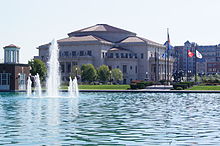By Adam Aasen
For the second straight year, The Center for the Performing Arts is reporting a surplus.
The Carmel-based center, which includes The Palladium, The Studio Theater and The Tarkington, reported an income totaling $8,707,684 and expenses totaling $8,447,239.
Last year, the Center took part in the Greater Indianapolis Performing Arts Market Survey, which reported that in four years, the Center became the fourth most familiar performing arts organization in the Indianapolis area.

“It was a year of growth and vibrancy across the organization,” said President/CEO Tania Castroverde Moskalenko in a statement. “With increasing support, we are positioned to accomplish great things by providing more world-class arts and entertainment, interactive learning, and creative community engagement for the region.”
The 2014-15 fiscal year surplus is at $260,000, compared to a $177,000.
Celebrating its fifth anniversary, the Center hasn’t always posted such surplus. Before it opened in 2010, the Center sought $2 million for pre-opening expenses and another $2 million in 2011 when there was a shortfall, according to previous Current articles. Between 2010 and 2013, there was $12 million in government assistance for the Center, according to past news reports.
When Moskalenko first took the job in 2012, she replaced interim CEO Frank Basile who was at the helm after Steven Libman’s resignation. Moskalenko saw fundraising decrease from $2 million prior to her taking the job to $1.3 million in her first year. But in that time since, fundraising has substantially improved.
Diana Syrcle, the Center’s side president of development, has led the Center’s fundraising with impressive results, including an 114 percent increase in building and room rentals in fiscal year 2015 compared to 2014. Syrcle also decrease the amount of time from a patrons first visit to the center and they time they decide to donate. Previous it was 36 months but it has now been shortened to 28 months.
Carmel Mayor Jim Brainard praised Moskalenko for her work fundraising and managing the budget.
“Like all institutions, it takes a few years to get it on its feet and get a base of donors,” he said. “We’re continuing to work on that and we’re very pleased with Tania and her staff. They’re working hard and doing a really good job.”
While Brainard was happy with the Center’s surplus, he said it doesn’t necessarily mean the Center won’t ever need government assistance or that it can start paying off the building’s debt on its own. He said world-class concert halls aren’t built by the private sector and the city invests money in this organization to increase quality of life and attract new businesses, which he said in turn helps create additional tax revenue. Brainard said an economic impact study of the Center should be released soon.
In the past, city councilors such as Luci Snyder, Rick Sharp and Eric Seidensticker, who lost their elections last year, questioned requests for more money from the city council for the Center for the Performing Arts. They said they weren’t expected annual additional taxpayer expenses when they first approved constructing the hall. Brainard said he was always up front about the expenses associated.




